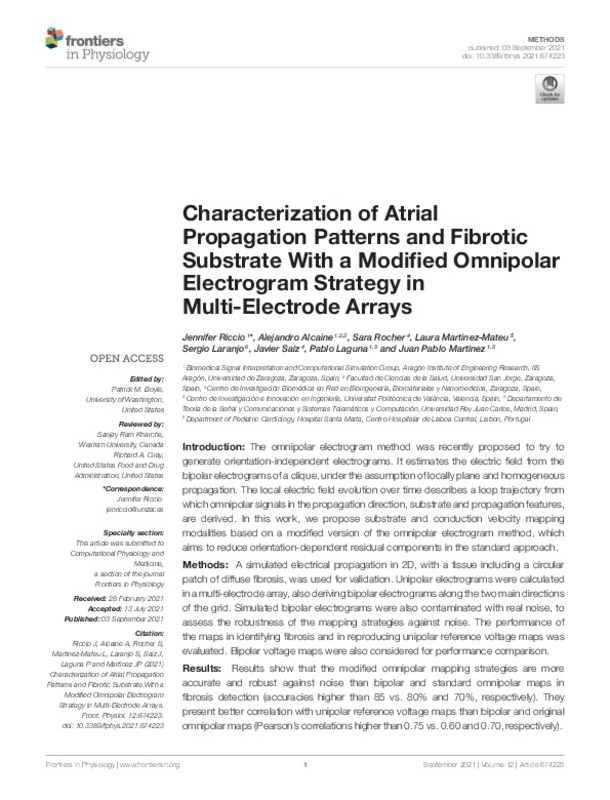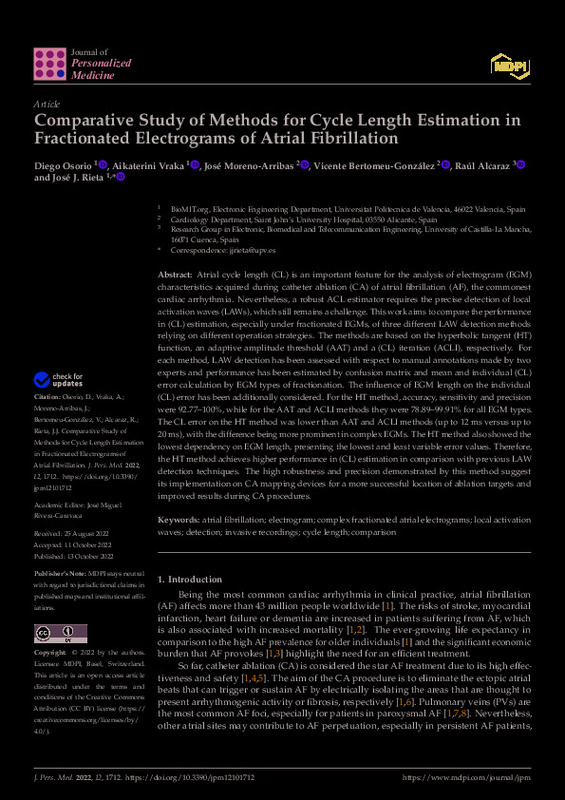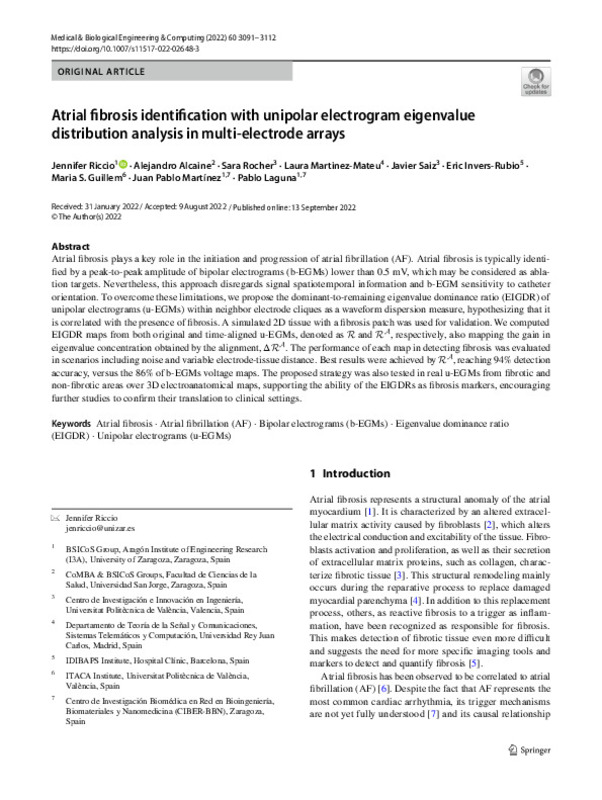Riccio, J.; Alcaine, A.; Rocher-Ventura, S.; Martínez-Mateu, L.; Laranjo, S.; Saiz Rodríguez, FJ.; Laguna, P.... (2021). Characterization of Atrial Propagation Patterns and Fibrotic Substrate With a Modified Omnipolar Electrogram Strategy in Multi-Electrode Arrays. Frontiers in Physiology. 12:1-21. https://doi.org/10.3389/fphys.2021.674223
Por favor, use este identificador para citar o enlazar este ítem: http://hdl.handle.net/10251/182190
|
Título:
|
Characterization of Atrial Propagation Patterns and Fibrotic Substrate With a Modified Omnipolar Electrogram Strategy in Multi-Electrode Arrays
|
|
Autor:
|
Riccio, Jennifer
Alcaine, Alejandro
Rocher-Ventura, Sara
Martínez-Mateu, Laura
Laranjo, Sergio

 Saiz Rodríguez, Francisco Javier
Laguna, Pablo
Martínez, Juan Pablo
Saiz Rodríguez, Francisco Javier
Laguna, Pablo
Martínez, Juan Pablo
|
|
Entidad UPV:
|
Universitat Politècnica de València. Centro de Investigación e Innovación en Bioingeniería - Centre de Recerca i Innovació en Bioenginyeria
Universitat Politècnica de València. Departamento de Ingeniería Electrónica - Departament d'Enginyeria Electrònica
|
|
Fecha difusión:
|
|
|
Resumen:
|
[EN] Introduction: The omnipolar electrogram method was recently proposed to try to generate orientation-independent electrograms. It estimates the electric field from the bipolar electrograms of a clique, under the ...[+]
[EN] Introduction: The omnipolar electrogram method was recently proposed to try to generate orientation-independent electrograms. It estimates the electric field from the bipolar electrograms of a clique, under the assumption of locally plane and homogeneous propagation. The local electric field evolution over time describes a loop trajectory from which omnipolar signals in the propagation direction, substrate and propagation features, are derived. In this work, we propose substrate and conduction velocity mapping modalities based on a modified version of the omnipolar electrogram method, which aims to reduce orientation-dependent residual components in the standard approach.
Methods: A simulated electrical propagation in 2D, with a tissue including a circular patch of diffuse fibrosis, was used for validation. Unipolar electrograms were calculated in a multi-electrode array, also deriving bipolar electrograms along the two main directions of the grid. Simulated bipolar electrograms were also contaminated with real noise, to assess the robustness of the mapping strategies against noise. The performance of the maps in identifying fibrosis and in reproducing unipolar reference voltage maps was evaluated. Bipolar voltage maps were also considered for performance comparison.
Results: Results show that the modified omnipolar mapping strategies are more accurate and robust against noise than bipolar and standard omnipolar maps in fibrosis detection (accuracies higher than 85 vs. 80% and 70%, respectively). They present better correlation with unipolar reference voltage maps than bipolar and original omnipolar maps (Pearson's correlations higher than 0.75 vs. 0.60 and 0.70, respectively).
Conclusion: The modified omnipolar method improves fibrosis detection, characterization of substrate and propagation, also reducing the residual sensitivity to directionality over the standard approach and improving robustness against noise. Nevertheless, studies with real electrograms will elucidate its impact in catheter ablation interventions.
[-]
|
|
Palabras clave:
|
Atrial fibrosis
,
Atrial fibrallation
,
Multi-electrode array
,
Unipolar electrograms
,
Bipolar electrograms
,
Omnipolar electrogram
,
Modified omnipolar electrogram
,
Conduction velocity
|
|
Derechos de uso:
|
Reconocimiento (by)
|
|
Fuente:
|
Frontiers in Physiology. (issn:
1664-042X
)
|
|
DOI:
|
10.3389/fphys.2021.674223
|
|
Editorial:
|
Frontiers Media SA
|
|
Versión del editor:
|
https://doi.org/10.3389/fphys.2021.674223
|
|
Código del Proyecto:
|
info:eu-repo/grantAgreement/AEI/Plan Estatal de Investigación Científica y Técnica y de Innovación 2017-2020/PID2019-104881RB-I00/ES/ANALISIS DE SEÑAL BASADO EN LA FISIOLOGIA PARA EL GUIADO DEL MANEJO Y TERAPIA DE ARRITMIAS CARDIACAS/
info:eu-repo/grantAgreement/GENERALITAT VALENCIANA//ACIF%2F2018%2F174//AYUDA PREDOCTORAL GVA-ROCHER VENTURA. PROYECTO: DESARROLLO DE MODELOS COMPUTACIONALES 3D PERSONALIZADOS DE AURICULA PARA LA OPTIMIZACION DEL TRATAMIENTO DE LA FIBRILACION AURICULAR./
info:eu-repo/grantAgreement/AEI/Plan Estatal de Investigación Científica y Técnica y de Innovación 2017-2020/PID2019-105674RB-I00/ES/TOWARDS IMPROVED MANAGEMENT OF CARDIOVASCULAR DISEASES BY INTEGRATIVE IN SILICO-IN VITRO-IN VIVO RESEARCH INTO HEART¿S STRUCTURE, FUNCTION AND AUTONOMIC REGULATION/
info:eu-repo/grantAgreement/EC/H2020/766082/EU
|
|
Agradecimientos:
|
This study has received funding from the European Union's Horizon 2020 research and innovation program under the Marie Sklodowska-Curie grant agreement No 766082 (MY-ATRIA project), from projects PID2019-104881RB-I00, and ...[+]
This study has received funding from the European Union's Horizon 2020 research and innovation program under the Marie Sklodowska-Curie grant agreement No 766082 (MY-ATRIA project), from projects PID2019-104881RB-I00, and PID2019-105674RB-I00 from MICINN, Spain, from Gobierno de Aragon (BSICoS Group T39-20R) cofunded by FEDER 20142020 Building Europe from Aragon and from Generalitat Valenciana through the fellowship ACIF/2018/174 and the grant PROMETEO/2020/043.
[-]
|
|
Tipo:
|
Artículo
|












